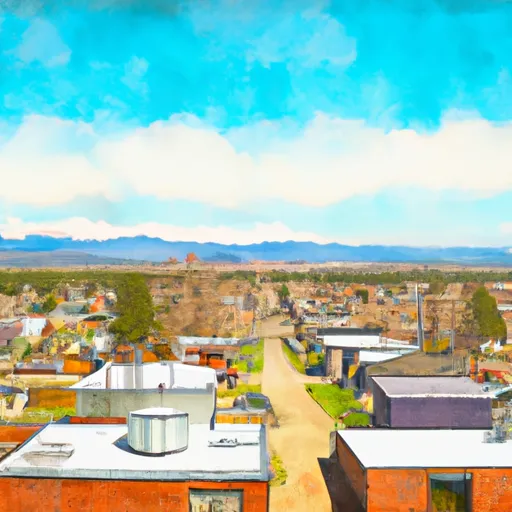-
 Snoflo Premium
Snoflo Premium
Get unlimited access to all our content
With no Ad interruptions! - Start Your Free Trial Login with existing account
La-Jara
Eden Index
Climate
6.5
•
Recreation
1.8
•
Community
•
Safeguard
3.2/10

La Jara, located in southern Colorado, is a small town known for its diverse outdoor recreational opportunities and unique climate. Situated in the San Luis Valley, La Jara experiences a semi-arid climate with mild winters and warm summers. The area receives around 10 inches of precipitation annually, with most occurring as snow during the winter months.
Hydrologically, La Jara benefits from the nearby Rio Grande River, which provides a reliable water source for agricultural activities in the region. The river also offers fishing opportunities for anglers, with various species such as trout and bass available.
Outdoor enthusiasts visiting La Jara can explore the nearby San Juan and Sangre de Cristo Mountains, which provide excellent hiking, camping, and wildlife viewing opportunities. The Great Sand Dunes National Park and Preserve is within driving distance, offering stunning sand dunes, hiking trails, and the chance to engage in sandboarding or sledding.
In summary, La Jara boasts a mild climate, access to the Rio Grande River, and proximity to picturesque mountain ranges, making it an ideal destination for outdoor recreation enthusiasts.
What is the Eden Index?
The Snoflo Eden Index serves as a comprehensive rating system for regions, evaluating their desirability through a holistic assessment of climate health, outdoor recreation opportunities, and natural disaster risk, acknowledging the profound impact of these factors on livability and well-being.
Climate Health Indicator (CHI): 6.5
La-Jara receives approximately
214mm of rain per year,
with humidity levels near 69%
and air temperatures averaging around
6°C.
La-Jara has a plant hardyness factor of
5, meaning
plants and agriculture in this region thrive during a short period during spring and early summer. Most
plants will die off during the colder winter months.
By considering the ideal temperature range, reliable water supplies, clean air, and stable seasonal rain or snowpacks, the Climate Health Indicator (CHI) underscores the significance of a healthy climate as the foundation for quality living.
A healthy climate is paramount for ensuring a high quality of life and livability in a region, fostering both physical well-being and environmental harmony. This can be characterized by ideal temperatures, reliable access to water supplies, clean air, and consistent seasonal rain or snowpacks.
Weather Forecast
Streamflow Conditions
Rio Grande Headwaters
Area Rivers
Rio Grande Headwaters
Snowpack Depths
Rio Grande Headwaters
Reservoir Storage Capacity
Rio Grande Headwaters
Groundwater Levels
Recreational Opportunity Index (ROI): 1.8
The Recreational Opportunity Index (ROI) recognizes the value of outdoor recreational options, such as parks, hiking trails, camping sites, and fishing spots, while acknowledging that climate plays a pivotal role in ensuring the comfort and consistency of these experiences.
Access to outdoor recreational opportunities, encompassing activities such as parks, hiking, camping, and fishing, is crucial for overall well-being, and the climate plays a pivotal role in enabling and enhancing these experiences, ensuring that individuals can engage in nature-based activities comfortably and consistently.
Camping Areas
| Campground | Campsites | Reservations | Toilets | Showers | Elevation |
|---|---|---|---|---|---|
| Laguna Larga | 7 | 9,008 ft | |||
| Mogote | 59 | 8,426 ft | |||
| Los Pinos | 5 | 8,453 ft | |||
| Hopewell Lake | 21 | 9,770 ft |
Nearby Fishing
Nearby Ski Areas
Catastrophe Safeguard Index (CSI):
The Catastrophe Safeguard Index (CSI) recognizes that natural disaster risk, encompassing floods, fires, hurricanes, and tornadoes, can drastically affect safety and the overall appeal of an area.
The level of natural disaster risk in a region significantly affects safety and the overall livability, with climate change amplifying these risks by potentially increasing the frequency and intensity of events like floods, fires, hurricanes, and tornadoes, thereby posing substantial challenges to community resilience and well-being.
Community Resilience Indicator (CRI):
The Community Resilience Indicator (CRI) recognizes that education, healthcare, and socioeconomics are crucial to the well-being of a region. The CRI acknowledges the profound impact of these elements on residents' overall quality of life. By evaluating educational resources, healthcare accessibility, and economic inclusivity, the index captures the essential aspects that contribute to a thriving community, fostering resident satisfaction, equity, and social cohesion.

